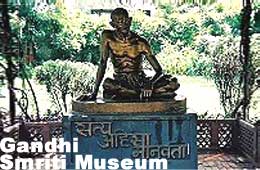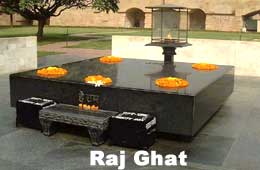| India Profile » Monuments and Temples in India » Gandhi Smriti | |
Gandhi Smriti | |
 | |
|
>
Gandhi Smriti Museum
National Gandhi Museum The origin of National Gandhi Museum traced to the period soon after the assassination of Mahatma Gandhi on January 30, 1948. The Hriday Kunj is outside the main building. It is the replica of the complex with similar name in the Sabarmati Ashram. Gandhi's room is fully furnished. However, Kasturba, his wife's room was bare. A courtyard faces her room. A kitchen and a guest room are the part of the complex. The slow process of collecting and preserving the personal relics, manuscripts, books, journals and documents, photographic and audio-visual material for the Museum on the life, philosophy and work of Mahatma Gandhi. It began in a modest way in Mumbai. The work was later shifted to Delhi and in early 1951; the nucleus of a Museum on Gandhi was set up in the Government hutments adjoining Kota House. Later still, in mid-1957, it was shifted to the colorful old mansion at 5, Mansingh Road. It was finally shifted to its present new and permanent home, most appropriately built opposite the Samadhi of Mahatma Gandhi in 1959. The imposing two storey Museum was formally inaugurated by Dr. Rajendra Prasad, the President of India on January 30, 1961. The Museum was named 'Gandhi Memorial Museum' (Gandhi Smarak Sangrahalaya), now commonly known as 'National Gandhi Museum' (Rashtriya Gandhi Sangrahalaya).
The museum has a charkha or spinning wheel section. It displays different types of spinning wheels. A huge hall exhibits photographs of Gandhi's life from a very young age. A new gallery exhibits his personal belongings like towel, clothes, pen and barrister box. There is a gallery, which contains paintings on Gandhi made by various artists. One work is on peanut and another of wire on wood. A batik piece and a tapestry from Kashmir are also there. A glass case contains the white garment Gandhiji had worn when he was shot. Raj Ghat The ghats, the steps leading down the river or water body , is the place marked for cremation of the famous leaders and political figures of India. Raj Ghat, resting place of mahatma Gandhi, is not far from the banks the River Yamuna. It is a simple square platform made of black marble. A commemorative ceremony takes place every Friday. Prayers are held in remembrance of Mahatma on the Birth (2nd October) and Death (30th January) Anniversaries. An eternal flame keeps burning in the Raj Ghat. The words "Hey Ram" are inscribed near the black platform. These are the last two words which mahatma uttered when he was shot. |
|
 |
 During his last days, Mahatma Gandhi lived in the Birla House on Tees January Marg. It was a huge colonial bungalow designed by a French architect for the famous Indian industrialist G. D. R. Birla. Gandhi's bedroom is kept the way as he left it. There 11 items in totality including his glasses and the walking stick. This place is known as Gandhi Smriti Museum and the government's official museum dedicated to the Mahatma. The pictures and the texts tell about the life of Gandhi as well as the independence movement. A collection of dioramas presents the events in the life of Gandhi. There are 10 different documentaries available on request for viewing. A sober prayer ground is in the back of the garden. An eternal flame marks this place where Gandhi expired in the back garden. A gallery has memorabilia of Mahatma Gandhi including an exhibition of dolls created by Sushila Gokhale and donated by the Gandhi Exhibition Trust, Mumbai.
During his last days, Mahatma Gandhi lived in the Birla House on Tees January Marg. It was a huge colonial bungalow designed by a French architect for the famous Indian industrialist G. D. R. Birla. Gandhi's bedroom is kept the way as he left it. There 11 items in totality including his glasses and the walking stick. This place is known as Gandhi Smriti Museum and the government's official museum dedicated to the Mahatma. The pictures and the texts tell about the life of Gandhi as well as the independence movement. A collection of dioramas presents the events in the life of Gandhi. There are 10 different documentaries available on request for viewing. A sober prayer ground is in the back of the garden. An eternal flame marks this place where Gandhi expired in the back garden. A gallery has memorabilia of Mahatma Gandhi including an exhibition of dolls created by Sushila Gokhale and donated by the Gandhi Exhibition Trust, Mumbai. 